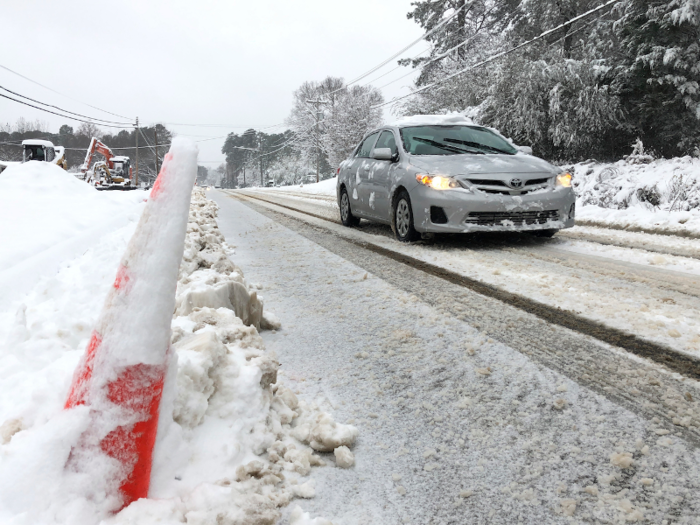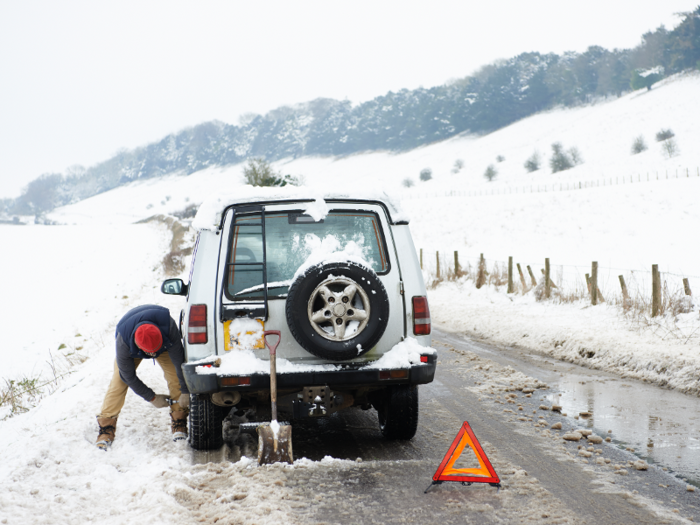- Home
- slideshows
- miscellaneous
- The 8 worst mistakes people make while driving in the winter
The 8 worst mistakes people make while driving in the winter
Driving too fast for winter road conditions is the single biggest mistake you can make.

On the other hand, driving too slowly in winter conditions is also a dangerous mistake.

During wintertime, overly slow driving can cause an accident just as easily as excessive speed.
"Moving slower than the pace of surrounding traffic can contribute to accordion-style chain reaction crashes because drivers coming up from behind may not recognize the difference in speed and adjust soon enough," Rogers said.
"Crawling along because you are scared to drive in the conditions" increases the danger you pose to yourself and others, Rogers said. Instead, maintain speeds similar to other vehicles on the road, or else stay off the road when you don't feel confident you can drive safely.
Driving with tires that lack proper tread depth for winter conditions puts you at risk of losing control of your vehicle.

"Road traction is key for safe winter driving. Pay attention to your tires and how they make contact with the road," Rick Ricart of Ricart Automotive Group said. If your tire treads are not of proper depth for the conditions, you put yourself at risk of losing control of your car.
Rogers told Business Insider that tire traction in winter weather depends on thread depth.
"You need that depth to chew through loose snow and slush, while shallow tread depth can only nibble at it," he said. "Generally, your tires need about 5/32 of an inch or more of tread depth to handle winter weather."
You can test for proper tread depth by inserting a penny between the treads, with President Lincoln's head facing inward. If you can see the top of his head, the tires lack sufficient tread depth.
You put undue strain on your vehicle and put yourself at risk for a breakdown or an accident if you don't prep your car for winter.

"Failing to prepare your vehicle for winter conditions is one of the worst mistakes you can make," Ricart said.
In addition to ensuring your tires are ready for snow, slush, and ice, Ricart said you need to "make sure your fluids are topped off at the beginning of the winter season, and check that your car has quality wipers that can move water, ice, and road grime."
It's also a good idea to have the battery checked and replaced if it's not working at full capacity. And while at the shop, have a mechanic check the thermostat and heating system as well as drive belts, which are more prone to fail in subzero temperatures, especially if worn down.
Failing to thoroughly clear your vehicle of snow and ice limits your visibility and can make it harder for other drivers to see you.

"See and be seen," Rogers told Business Insider. "You can't be fully aware of all situations around you if you can't see, so scrape off all the frosty windows, give time for them to defrost, and clear off all the snow."
"And don't forget to keep head and taillights clean," Rogers said. "Many of today's vehicles have LED lighting, which are so much more efficient than traditional bulbs, but don't generate enough heat to melt snow or frost. If drivers behind you cannot see your taillights, they might not realize you are slowing down and might run into the back of you."
Overconfidence in your all-wheel drive vehicle can lead to spinouts and collisions.

Just because your vehicle has all-wheel drive doesn't mean you can trust it to handle all weather conditions.
"All-Wheel Drive vehicles can give a false sense of security and the wrong impression of how low the traction is on snowy or icy roads, because accelerating away from a stop can feel so effortless," Rogers said.
When it comes time to stop or turn, the all-wheel drive system does little to help you maintain control of the vehicle, and if your tires lose traction with the road, the system's capabilities mean nothing.
Don't use the brakes as the only defensive safety measure on wintry roads.

It's all too easy to focus on the bumper of the car ahead. But Rogers said "that sort of target fixation prevents you from being fully aware of the road conditions and driving situations ahead."
"Odds are the driver right in front of you has target fixation, too, and will react too late for you to react to what they do," he said. "That's how chain reaction crashes happen."
Instead of watching only the car ahead, look through and around that vehicle and know what is behind and beside your car.
"If a bad situation is unfolding in front of you, look for your escape route. Focus on where you want to go rather than on what you need to avoid. Your hands and feet will naturally aim your vehicle where your eyes are focused, driving you around trouble rather than plowing into the back of it," Rogers said.
Skipping regular tire pressure checks can lead to tire failure and presents a major safety risk.

Improperly inflated tires make it much harder for you to maintain proper control of your car, especially in winter conditions. Tires lose pressure over time, shedding approximately 1 psi per month and 1 psi for every 10 degrees of temperature drop.
"Don't ignore that orange pressure warning light on your dash," Rogers said. "It's telling you that you are at the threshold where tires can no longer safely carry the load of your vehicle. Ignore it long enough and [the tires] will eventually fail from a lack of air, creating a safety risk to you and your family."
Popular Right Now
Advertisement